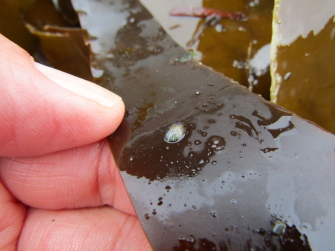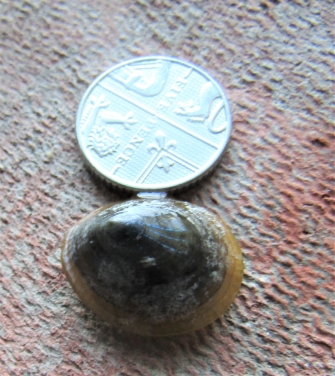
Blue-rayed limpets
Patella pellucida
.
The blue-rayed limpet is a relative of the limpets we commonly see on rocks and in rock pools high up on the shore. The blue-rayed limpet is very different, however. For a start, it has striking blue stripes on its shell, something not seen in its upper shore cousins. Also, blue-rayed limpets live heir lives on kelp, a large seaweed, which lives out at shore under water, only getting exposed at particualrly low tides.

Kelp is a large, sturdy seaweed with a thick stipe (like a stem) and long 'leathery' blades.

Kelp forests are only exposed at particularly low tides leaving blue-rayed limpets to live the vast majority of their lives under water.


The blue-rayed limpets living on kelp blades are only a few millimetres long. My thumb is handily placed for scale above...
The best way to see blue-rayed limpets is generally to snorkel over kelp forests. Alernatvely, for th land lubbers, as kelp forests can be too slippery to wade through even whent uncovered by the tide, is by examining parts of kelp washed up on the beach after a storm. Once you get used to looking, they can be found quite often, still clinging onto the blades of the kelp, even though it has become detached.
Even if you don't see the limpets themselves, you can sometimes see small depressions in the blades where the limpets have been eating.

In some areas, blue-rayed limpets can also be seen on serrated wrack (not in my area though!)

As blue-rayed limpets get older, the search for them switches from the blades, to the hold-fasts (shown above - the root-like growth that holds the kelp onto the rocks below).
As the limpets mature, they travel from the blades of the kelp down to the hold-fast where they make themselves a protective hollow in the stipe.


Sadly, the hollows the blue-rayed limpets can seal the fate of the limpet and its host as it can weaken the stipe to the extent that it can snap off. For this reason, kelp can often be found washed up on the beach with a hollowed-out stipe.









